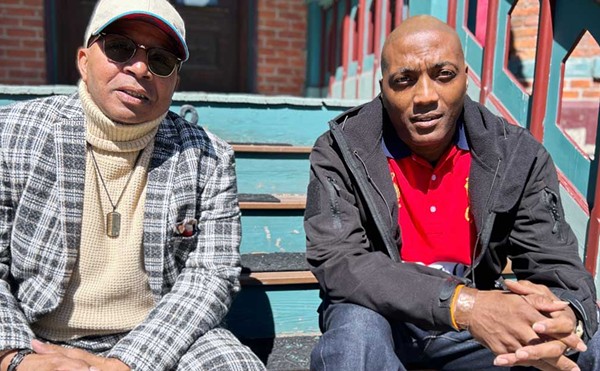Rob Mies is batty about bats. As the founder and executive director of the Bloomfield Hills-based Organization for Bat Conservation, Mies has been researching and educating the public about what may very well be our planet's most feared and misunderstood mammals. Need proof? In a few weeks bats will appear alongside witches, ghosts, and other monsters in the form of Halloween decorations.
Located behind the Cranbrook Institute of Science, the nonprofit has rescued specimens representing species from all around the world, from local Michigan bats to the Malayan Flying Fox — the world's largest bat, with a six-foot wingspan. Mies has taken his bats far and wide, bringing his furry friends on The Tonight Show with Conan O'Brien and Ellen Degeneres. This past week, the organization co-hosted the 13th Annual Great Lakes Bat Festival with the Ann Arbor Hands-On Museum, and launched a Save the Bats campaign. We stopped by to see some of their bats up close and find out just why bats deserve a better rap.
Metro Times: How did you get into "the bat scene?"
Rob Mies: I was going to Eastern Michigan University, getting my undergraduate there. I heard about a bat study and I thought that sounded kind of neat. I went out with some researchers and found out how interesting bats were. I asked all these questions, and more questions, and more questions. I started designing my own projects, like working with apple orchard farmers who wanted to help control insects. It was written up in a newspaper one time, and a school heard about it and asked me to talk at their school. That started getting me into education. I kind of miss the research, but (conservation) is so important. What I saw was there's all this great information about science that's known, but the public doesn't know it.
I've been doing this for 22 years. We talk to over 100,000 people every year. We need to talk to millions of people. The week of Oct. 26 to Nov. 1 is National Bat Week. We're working with government agencies and other non-profit organizations. Probably millions of people will hear about it.
MT: What are some of the problems that bats face?
Mies: There's a fungus that's been affecting bats called white nose syndrome. It grows on bats and caves and mines. We're losing about a million bats a year because this fungus keeps spreading across the United States. It just hit Michigan this year. I think over time we're going to see big changes in the environment. We're taking out a primary predator of nighttime insects. When you take out the predator things change pretty dramatically.
One of the biggest problems was that people ate bats — and still do — in Africa and Asia. So they're overhunted. There's also a lot of fear about bats. There's a lot of people who would just go out and shoot them or throw rocks at them. There's been this fear of bats worldwide for many, many years.
Bats are so unique, because they're the only mammals in the world that can fly. They hang upside down, which is weird to people. They have wings — that creeps a lot of people out. I think because of the uniqueness, and because of the misinformation, you put all those things together and bats have had a really hard time.
MT: What are you guys doing to help bats?
Mies: We're launching our Save the Bats campaign. It's a nationwide campaign to teach people that bats aren't scary, that they're beneficial, and that they're disappearing.
There's three main things that people can do. You can put up bat houses, because it gives them a good safe warm dry place to raise their babies. It provides them another place to live so they don't live in our attic or behind our shutters.
We have a lot of animals that I call the four Bs: the bees, the butterflies, the birds, and the bats. They're all beneficial, but they're also disappearing. Simple things like planting wildflower gardens will give the bees and birds and butterflies nectar to drink from. At night, moths come too, and bats will come and eat the moths.
We also have an ambassador program. People can join anywhere in the United States and help teach other people about bats. A lot of the Save the Bats campaign is just giving people resources. We've got plans on our website for how to build your own bat house.
A year ago, my wife and I wrote a nonfiction book about bats, Bats A to Z. There's not a lot of nonfiction about bats for kids. If (kids) latch onto something like this, they're bat experts by third grade!
MT: What kind of bats do we have here in Michigan?
Mies: We have the evening bat and the big brown bat. Most of our bats are only an inch and a half to three inches in body length. They have a wingspan of about eight inches to about 14 inches. They all eat insects in Michigan — most bats in the entire United States only eat insects. They eat more insects than anything else at night — moths, beetles, gnats, flies, and mosquitos. Scientists estimate U.S. farmers benefit an average of $23 billion dollars annually in insect control (from bats).
They're also pollinators. In the wild, bats pollinate bananas, mangoes, and avocados. Agave, that we make tequila from, is only pollinated by bats. Without bats, margaritas would not have a good kick.
MT: What about the Bacardi rum logo, with the bat?
Mies: I got a chance to visit the factory in Puerto Rico. I was hearing from people who have been there a long time. Basically, it came from Spain. Bats were kind of seen as a group of animals that stayed together all the time, and that they were resilient. One of the rulers of Spain saw that as something to emulate, so he thought bats were really good. Years later when the Bacardi family were looking for an animal that they could use, they thought the same thing. They're family — Bacardi is still family-owned. So that's why they use the bat. — mt
The Organization for Bat Conservation is located at 39221 Woodward Ave, Bloomfield Hills; 248-645-3232; batconservation.org.—






